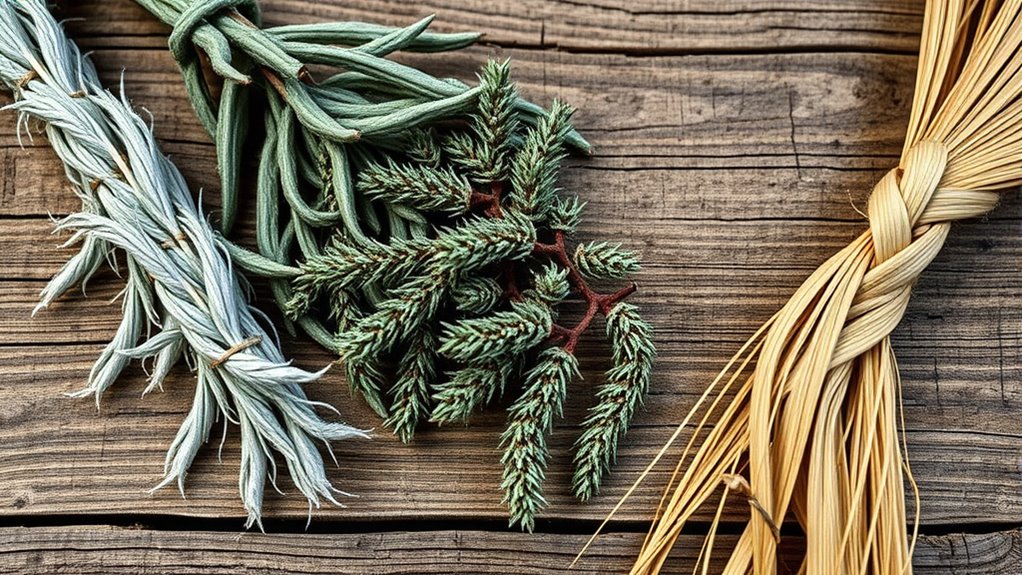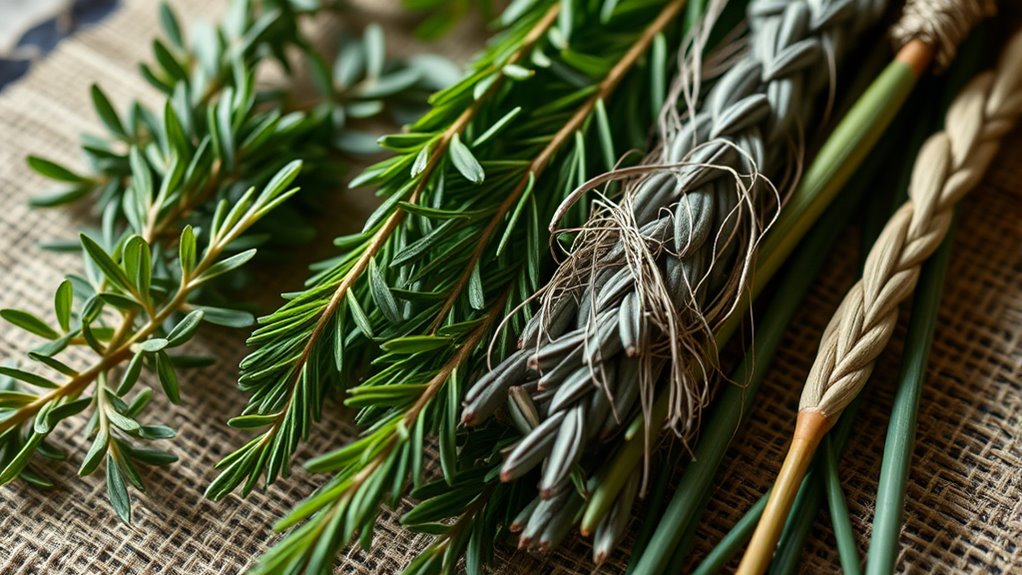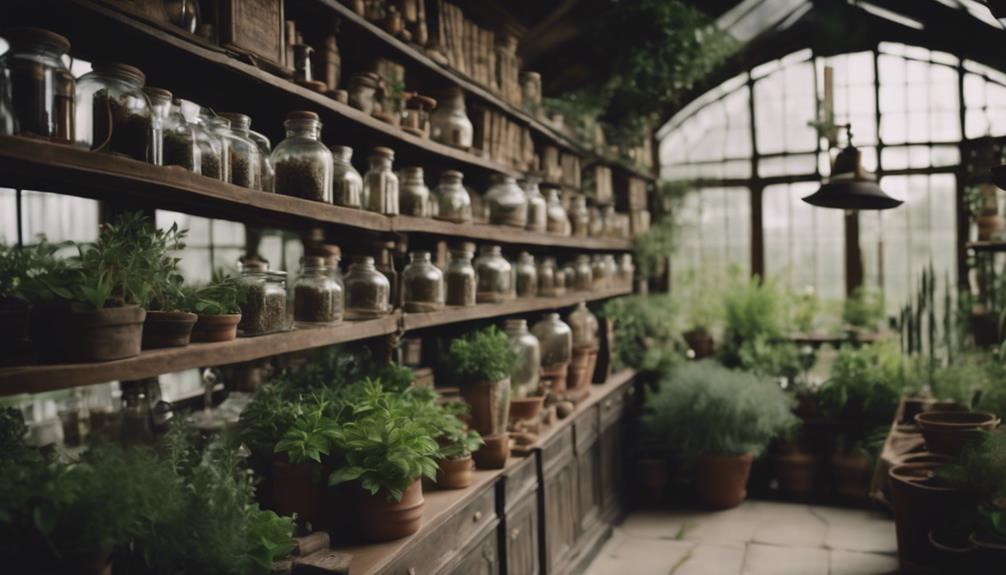Sacred plants like sage, cedar, and sweetgrass hold deep spiritual and cultural significance in many indigenous traditions. You’ll find that these plants are used for ritual cleansing, offerings, and connecting with ancestors and spiritual domains. They also symbolize life, resilience, and purity, with practices rooted in respect, sustainability, and cultural teachings. If you continue exploring, you’ll discover how these plants are preserved and honored across generations, ensuring their sacred roles endure.
Key Takeaways
- Sacred plants like sage, cedar, and sweetgrass serve as spiritual tools for purification, healing, and cultural continuity in indigenous traditions.
- These plants are harvested with reverence, prayers, and sustainable practices to honor their spiritual significance and ecological balance.
- Cedar symbolizes life, resilience, and spiritual connection, often used in rituals for purification and protection.
- Sweetgrass represents purity and divine presence, used to invite positive energies and foster community harmony.
- Proper respectful use and conservation of these sacred plants help preserve indigenous cultural heritage and ecological sustainability.
The Cultural Significance of Sage in Indigenous Traditions

Sage holds a deep spiritual significance in many Indigenous traditions, serving as a sacred tool for purification and connection with the divine. When you harvest sage, you participate in a ritual that emphasizes respect for the plant and its spiritual power. Plant harvesting isn’t casual; it’s done with reverence, often accompanied by prayers and offerings. The ritual significance of sage extends beyond just gathering; it’s integral to ceremonies, cleansing spaces, and healing practices. You might use sage to clear negative energy or to mark important spiritual events. This act of harvesting is more than gathering herbs — it’s a sacred act that maintains balance between humans and nature. Through these rituals, sage becomes a conduit for spiritual renewal and cultural continuity. Proper Plant harvesting practices ensure the sustainability of sage populations and honor the spiritual traditions associated with it. Additionally, understanding the cultural context of sage use helps preserve its sacred role within Indigenous communities. Recognizing the spiritual importance of sage reinforces the need for respectful and mindful harvesting practices. Respectful harvesting also involves understanding the environmental impact of gathering sage, which is crucial for maintaining healthy ecosystems.
Cedar: A Sacred Tree and Its Ritual Uses

Cedar holds a revered place in many Indigenous cultures as a sacred tree with profound spiritual significance. You recognize its role in rituals, often using cedar bark for purification or crafting ceremonial items. The tree’s strength and resilience symbolize life and connection to the spiritual domain. Cedar medicine, derived from the bark and other parts, is used for healing and protection. Its aromatic qualities are also believed to carry prayers to the divine, reinforcing its sacred role in rituals. Additionally, spiritual symbolism associated with cedar emphasizes its importance as a conduit between the physical and spiritual worlds, underscoring its sacred uses. The cultural significance of cedar is deeply rooted in tradition and storytelling, passing down its sacred value through generations. Moreover, understanding the AI security concerns related to the protection of such cultural knowledge is increasingly important in preserving indigenous heritage. Recognizing the environmental importance of cedar highlights the need for sustainable harvesting practices to ensure its continued role in cultural and spiritual practices. The biological resilience of cedar also contributes to its enduring presence in these traditions, making it a vital element of Indigenous spirituality and ecology.
The Role of Sweetgrass in Spiritual Ceremonies

In many Indigenous rituals, sweetgrass is cherished for its gentle, uplifting aroma and its role in connecting people to spiritual domains. Its fragrant sweetness symbolizes purity and the presence of the divine, making it an essential part of ceremonial offerings. During ceremonies, you burn sweetgrass to invite positive energies and create a sacred space, believing its aromatic smoke facilitates botanical healing and spiritual cleansing. The scent helps participants focus their intentions and deepen their connection to ancestral spirits. Sweetgrass is often woven into bundles and used as an offering to honor spirits and ancestors, reinforcing harmony and respect within the community. Its role in spiritual ceremonies underscores its importance as a sacred plant that fosters spiritual renewal and holistic well-being. Recognizing the significance of angel numbers can further enhance understanding of divine guidance during these sacred practices. Additionally, the aromatic properties of sweetgrass are thought to promote emotional well-being and mental clarity, supporting the overall spiritual experience. Incorporating traditional practices can also amplify the spiritual benefits of sweetgrass during ceremonies. Understanding the cultural significance of sweetgrass enriches its role in fostering community and spiritual connection. Moreover, engaging with personal development techniques such as mindfulness can deepen the spiritual experience during rituals involving sweetgrass.
Traditional Methods of Harvesting and Preparing Sacred Plants

Traditional methods of harvesting sacred plants emphasize respecting the plant’s natural growth cycle and environment. You carefully choose the right time, such as when plants are mature but not overgrown, to ensure their continued health. Sustainable harvesting techniques involve taking only what is needed, avoiding damage to the root systems, and leaving enough plant material to regenerate. To support plant conservation, you might:
- Use gentle tools like scissors or knives to minimize harm
- Harvest leaves or stems selectively rather than uprooting entire plants
- Follow community traditions that set guidelines for sustainable collection
- Incorporate proper harvesting techniques to ensure the longevity of sacred plant populations and promote ecological balance in their habitats. Understanding the importance of plant reproductive cycles can help harvesters time their collections more effectively and sustainably. Additionally, recognizing the growth patterns of these plants can aid in determining the optimal periods for harvesting to maximize vitality and regeneration.
Furthermore, being aware of seasonal variations can assist in planning harvests that align with natural plant cycles, ensuring minimal disruption to their ecosystems.
Symbolism and Meaning Behind the Plants’ Use in Ceremonies

You recognize that sacred plants symbolize more than their physical presence—they embody spiritual connection and cleansing. These plants serve as a bridge to ancestors, honoring traditions and reinforcing respect. Understanding their deeper meanings enriches your appreciation of their role in ceremonies. In many Indigenous cultures, these plants are integral to community gatherings and rituals, emphasizing their importance beyond individual use cultural significance.
Spiritual Connection and Purification
Many indigenous cultures believe that sacred plants serve as more than just physical tools; they embody a profound spiritual connection that facilitates purification and divine communication. When you use plants like sage, cedar, or sweetgrass, you’re engaging in a ritual of spiritual cleansing that clears negative energies and promotes plant healing on a deeper level. These plants symbolize the bridge between the physical and spiritual worlds, helping you connect with ancestors and spirits. Their use enhances your awareness of spiritual energies and fosters harmony.
- Cleanse your aura and environment, creating sacred space.
- Invoke ancestral spirits for guidance and protection.
- Deepen your understanding of spiritual truths through plant-assisted insight.
Through this practice, you experience a powerful, sacred link that nurtures your soul and promotes spiritual healing.
Ancestral Traditions and Respect
Sacred plants carry deep symbolic meanings that honor the history and values of indigenous communities. They serve as living links to your ancestors, embodying traditions passed down through generations. Using these plants in ceremonies reflects respect for their spiritual significance and the community’s cultural adaptation over time. You understand that plant conservation is essential to preserve these precious resources, ensuring future generations can continue these sacred practices. When you engage in ceremonies with sage, cedar, or sweetgrass, you honor not only the plants but also the ancestral wisdom embedded in their use. This respect fosters a deeper connection to your heritage, reminding you that these traditions are crucial to maintaining cultural identity and spiritual harmony.
Contemporary Practices and Preservation of Sacred Plant Traditions

Despite the pressures of modernization and globalization, indigenous communities actively work to preserve their sacred plant traditions. They engage in botanical conservation efforts, ensuring the sustainable harvesting and protection of plants like sage, cedar, and sweetgrass. Many communities incorporate traditional knowledge into modern herbalism, blending age-old practices with contemporary health trends. This integration helps strengthen cultural identity and promotes wider appreciation. You might observe initiatives such as community-led seed banks, educational programs, and collaborations with environmental groups. These efforts not only safeguard the plants themselves but also uphold spiritual and cultural significance. Additionally, the use of specialized planters and other innovative tools supports the cultivation and preservation of these sacred plants in various environments. For instance, some groups utilize indigenous cultivation techniques to adapt to changing climates and ensure ongoing access. Moreover, ongoing research and documentation play a crucial role in cultural preservation, helping to transmit traditional knowledge to younger generations. By actively participating in these practices, indigenous peoples make certain that sacred plant traditions endure despite external challenges, fostering cultural resilience and ecological sustainability.
Respect and Ethical Considerations in the Use of Sacred Plants

As you engage with sacred plants in indigenous traditions, it’s crucial to recognize the importance of respecting their spiritual and cultural significance. Always practice sustainable harvesting to guarantee these plants remain available for future generations and to honor the ecosystems they belong to. Be mindful of cultural appropriation, understanding that these plants are more than mere resources—they embody sacred traditions and identities. Avoid using sacred plants outside of their cultural context without proper permission or understanding, as this can be disrespectful and harmful. Instead, seek to learn from indigenous communities and support their efforts to preserve these essential traditions. Respecting sacred plants means honoring their origins, practicing responsible use, and acknowledging their deep spiritual significance.
Frequently Asked Questions
How Do Indigenous Groups Ensure Sustainable Harvesting of These Sacred Plants?
You can guarantee sustainable harvesting by practicing traditional harvesting methods that respect the plants’ growth cycles. Indigenous groups often implement cultural conservation practices, such as only taking what’s needed and leaving enough for regrowth. They also educate community members about the importance of these plants, emphasizing respect and care. This mindful approach helps preserve sacred plants like sage, cedar, and sweetgrass for future generations while honoring their spiritual significance.
Are There Specific Myths or Stories Associated With Each Plant’s Origin?
You might think these plants just grew naturally, but their mythical origins are woven into rich cultural stories. Sage, cedar, and sweetgrass each have tales explaining their sacredness—like cedar’s story of providing shelter or sweetgrass’s connection to harmony. Ironically, these stories underscore their divine importance, reminding you that these plants aren’t just natural resources but sacred symbols rooted in ancient myths that shape cultural identity and spiritual practice.
How Have Modern Environmental Issues Affected Sacred Plant Populations?
Climate change and habitat loss have critically reduced sacred plant populations, impacting Indigenous practices. You might notice dwindling sage, cedar, and sweetgrass supplies, as rising temperatures and deforestation threaten their growth. These environmental issues disrupt traditional ceremonies and cultural preservation. To address this, you can support conservation efforts and sustainable harvesting practices, ensuring these essential plants remain available for future generations and continue their spiritual significance.
Can Sacred Plants Be Legally Protected or Are They at Risk of Extinction?
Sacred plants like sage, cedar, and sweetgrass are fighting an uphill battle, but they can be protected through legal measures. You can support conservation efforts that establish protected areas and regulate harvesting, ensuring these plants don’t slip through your fingers like grains of sand. Laws and community-led initiatives are essential, giving sacred plants a fighting chance to thrive and preserving their spiritual and ecological significance for generations to come.
What Are the Differences in Plant Use Among Various Indigenous Cultures Worldwide?
You’ll notice that different indigenous cultures worldwide assign unique cultural significance and incorporate sacred plants into their ritual practices. For example, some cultures use sacred plants like tobacco in ceremonies, while others rely on plants like palo santo for cleansing. These plants hold deep spiritual meaning, shaping their traditions and rituals. You’ll see that plant use varies greatly, reflecting each culture’s history, environment, and spiritual beliefs.
Conclusion
As you immerse yourself in the sacred plants’ gentle aroma and vibrant rituals, remember that these traditions carry the heartbeat of indigenous cultures. Their smoky tendrils curl into the sky, whispering stories of respect, harmony, and reverence. By honoring their sacredness and practicing ethically, you become part of a living tapestry—protecting these spiritual gifts for generations to come. Let their ancient wisdom inspire you to nurture and preserve these sacred bonds with humility and care.










